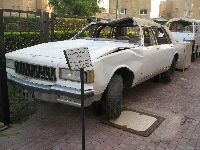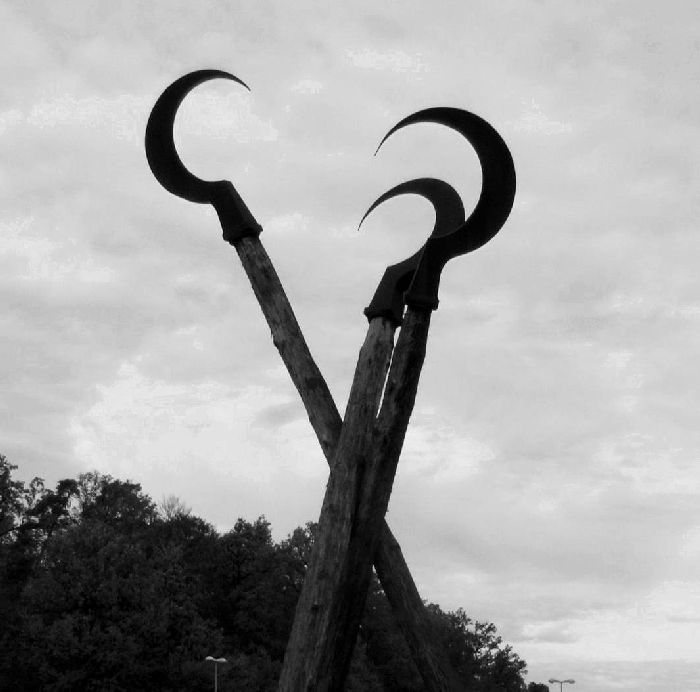Al Qurain Martyrs Museum in Kuwait
Pictures and text by Wayne Keeter
The Al-Qurain Martyr's Museum is the home of a gruesome battle lasting 10 long hours between
invading Iraqi troops and a group of Kuwait freedom fighters called the Al-Massilah group.
The battle took place on February 24th, 1991, during the Iraq occupation of Kuwait. The
battleground that this took place on is now home to the Al-Qurain Martyr's Museum, a
memorial for those lost during the Iraq occupation.
The Al-Qurain Martyr's Museum is the home of a gruesome battle lasting 10 long hours between invading Iraqi troops and a group of Kuwait freedom fighters called the Al-Massilah group. The battle took place on February 24th, 1991, during the Iraq occupation of Kuwait. The battleground that this took place on is now home to the Al-Qurain Martyr's Museum, a memorial for all who were lost during the Iraq occupation.
The Al-Massilah group consisted of 31 members. The members were young men who strongly believed in Allah and their cause, taking an oath to sacrifice everything to uphold the pride and honor of their country. Men all over the country formed battle groups just like Al-Massilah to help protect their country against the enemy. The men obtained weapons in various ways, including purchasing them from Iraqi troops for low prices in order for the Iraq troops to buy food and water. The Al-Massilah group concentrated on sniping Iraqi soldiers and planting bombs on Iraqi munition trucks. When the Iraqi troops set up stronger control over the area, the Al-Massilah group chose a safer place to gather and retreated to the Al-Qurain district since it was a newer area and the Iraqi's were unfamiliar with it.
The day this battle took place, the Al-Massilah group brought their weapons out of hiding, preparing to attack the Iraqi forces. They wore a uniform, designed by the leader, consisting of a white shirt inscribed with the name and motto of the group. While they were gathering their weapons and discussing their plans, a van holding Iraqi troops was on patrol in the neighborhood and came upon the house. They knocked on the door and no one answered. Upon orders to enter homes when no answer is given, the bloody battle began.
The Al-Massilah group was armed with nothing more than machine guns while the Iraq troops were constantly hitting them with much more, including 2 tanks positioned outside of the home. The tank fire scored enormous holes in the walls, causing some of them to crumble. The constant stream of endless shells and bullets ripped through the home, barely missing some of the men while devastatingly hitting others. The battle lasted from 8 in the morning until 6 in the evening. In these 10 grueling hours 19 members of the Al-Massilah group participated in the battle, 7 of whom barely survived and a devastating 12 became martyrs.
While visiting the memorial, you can see the catastrophic remains of the battle. Entire walls missing, floors completely gone and metal twisted in ways you wouldn't think possible. Gaping holes in the walls, staircases destroyed, windows exploded, and structures torn from their foundation. Seeing the actual battleground and being able to walk through the house were these men were fighting for their lives and their country nearly puts you at a loss for words.
There are plaques located around the house that show where the men lost their lives or were captured. When you visit this site and walk around what remains of the home, you can only imagine what these men must have gone through. Standing in the place where someone lost their life creates such raw emotion and gives you a rare glimpse of what it might have felt like to fight for everything you believe in, to the death.
The museum part of the house is on the bottom floor and displays various relics from the battle. There is a reconstructed scaled model of the area so that you can see it from a bird's eye view. There are pictures of the martyred men and the families they left behind. Shell casings, machine guns, and various documents are on display as well. The documents on display include memos given to the Iraqi troops during the occupation, with orders to "burn and destroy all the homes on which there are slogans hostile to our leadership, the pictures of the defunct Al-Sabah dynasty, or the Kuwaiti flags." "Burn and destroy every district in which any military, security, or Popular Army individual is martyred." "Arrest any person who owns, or keeps at his home, a weapon." "Annihilate any hostile demonstration."

|
.
|

|
.
|

|
View of the front of the home from where one of the tanks was located.
|

|
The back of the home.
|

|
A closer view of the side of the home where the second tank was located.
|

|
The side of the house including the roof where the wall was blown out from the tank. In this photo you can see how the metal was impacted and twisted from the blast.
|

|
From the ground looking up at the home where an exterior wall used to be located.
|

|
Another view from the ground looking up where the exterior wall used to be. You can see the piping and wiring for the home exposed from the blasts.
|

|
A hole was blown into the exterior wall of this room exposing the inside. You can see where the bullet holes and canon fire smashed into the walls.
|

|
An entrance into the home. You can see where the houses address was affixed to the building and nearly falling to the ground from the battle.
|

|
A plaque affixed to the truck used to transfer a group of resistance members from Kuwait city to the Al-Qurain area.
|

|
The truck used to transfer a group of resistance members from Kuwait city to the Al-Qurain area.
|

|
Plaque for the Chevrolet that belongs to the owner of the house and martyr, Bader Al-Eedan.
|

|
The Chevrolet that belongs to Bader Al-Eedan.
|

|
Plaque for the Chevrolet that belongs to the group leader which was used in military operations and medical necessities transition.
|

|
The Chevrolet that belongs to the group leader which was used in military operations and medical necessities transition.
|

|
Plaque for the white Chevrolet belonging to Iraqi intelligence.
|

|
The white Chevrolet belonging to Iraqi intelligence.
|

|
Plaque for the mini-bus belonging to Iraqi intelligence, used to transfer prisoners from Kuwait to Iraq and attack residences.
|

|
The mini-bus belonging to Iraqi intelligence, used to transfer prisoners from Kuwait to Iraq and attack residences.
|

|
One of the tanks used to attack the front of the Al-Qurain house.
|

|
Another view of one of the tanks used to attack the front of the Al-Qurain house.
|

|
Plaque showing the owner of the house, Bader Al-Eedan, a martyr.
|

|
A wall located on the interior of the house riddled with holes from gunfire and canon fire.
|

|
A plaque for eight of the martyr's that were captured.
|

|
The place where eight of the martyr's were captured.
|

|
A plaque for two of the men that hid in the attic and survived the battle.
|

|
The attic where two of the men hid and survived the battle.
|

|
The lower staircase showing signs of the battle.
|

|
Walking up the staircase is a view of destruction made in the home's exterior walls.
|

|
A plaque showing the place where the Captain Youssif Khodair Youssif Ali was killed. He was the third martyr in the battle.
|

|
A view of the place where Captain Youssif Khodair Youssif Ali was killed.
|

|
The hole blown all the way through the structure where Captain Youssif Khodair Youssif Ali was killed.
|

|
A view from the roof into the home and onto the roof. The walls both inside and outside were blown away during the battle.
|

|
A plaque showing the place where the leader Sayyed Hady Sayyed Mohammed Alawy was killed. He was the second martyr in the battle.
|

|
A view of the plaque and picture of the leader Sayyed Hady Sayyed Mohammed Alawy. This is where he was killed.
|

|
A view down to the road where the second tank was located during the battle.
|

|
The floor of the roof where the blasts created holes in the foundation.
|

|
A view from inside the home showing a missing wall and exposed piping from repeated blasts.
|

|
View of the structure on the roof destroyed during the battle.
|

|
A plaque in the museum for the leader of the Al-Massilah group, Sayyed Hady Sayyed Mohammed Alawy.
|

|
A photo of the leader of the Al-Massilah group, Sayyed Hady Sayyed Mohammed Alawy, as well as a photo of five of his nine children.
|

|
A plaque for martyr Hussain Ali Ghloom Rizah.
|

|
Photos of Hussain Ali Ghloom Rizah.
|

|
A wall with pictures of the martyrs lost in the battle as well as their families.
|

|
Plaques with the story of the Immortal Epic of Al-Qurain, in both English and Arabic.
|

|
A plaque showing the contents of a showcase filled with weapons used during the battle.
|

|
Weapons used during the battle.
|

|
Cannon shells from the battle.
|

|
A memo that circulated during the Iraq occupation dictating that all educational materials be transported to Iraq.
|

|
A memo that circulated during the Iraq occupation concerning a planned demonstration by the Kuwaitis and orders for the Iraqi troops to open fire.
|

|
Inside the museum there is a scaled replica of the home where the battle took place.
|

|
A view of the scaled replica of the home in the battle.
|

|
A close up view of a doorway in the replica.
|

|
A memo written by General H. Norman Schwarzkoff of the U.S. Military.
|























































